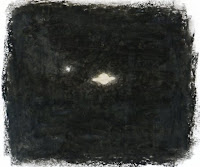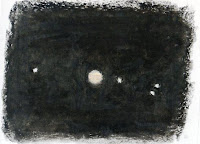It would be an interesting photographic project to try and capture the amazing hues that appear visually. It would be interesting, too, to try and capture the subtle colors and contrasts in paint. I’m not sure photography can duplicate the sensitivity of a human eye. And I’m pretty darn sure I don’t have the skill to do it with paint.
But I’m going to be giving both projects more thought. They’d both be fun and worth doing.
Nothing spectacular happened to me this weekend in any objective way, but subjectively I had so much fun this weekend that I had a hard time sitting down and calming down enough to write a draft of what I wanted to say in today’s post. If today’s post seems a little disorganized and random it’s because I’m not working from a first pass, but rather from a couple of pages of disconnected paragraphs I want to get to in one sequence or another.
*
Friday I decided to buckle down and try to capture something of the colors of Jupiter and Saturn through a small telescope using art tools. I didn’t want to try and depict the planets realistically, but simply to capture something of the view—the shimmering, small yet strangely interesting view—of the astronomical sights through the telescope.
Essentially, I was wondering if the ‘normal’ Impressionistic approach of the art world would make sense in what I’d always thought of as a scientific context.
I’m going to post a couple of images, briefly describe the scenes they were taken from, and then come back and talk more directly about the images.
*
 Friday night started with me observing Saturn in Leo almost due south. Although I’ve observed Saturn a great many times, there was a bit of an odd sensation Friday knowing that over the weekend I’d be trying to reproduce the view. I didn’t make any sketches there at the telescope—because then you have to worry about using a red light to avoid wrecking your night vision—but I paid attention to the image of Saturn while thinking in ‘artistic’ terms: I was conscious of hue and value, hard edges and soft, gradations, center and surround. (That’s Saturn’s largest moon Titan to the left.)
Friday night started with me observing Saturn in Leo almost due south. Although I’ve observed Saturn a great many times, there was a bit of an odd sensation Friday knowing that over the weekend I’d be trying to reproduce the view. I didn’t make any sketches there at the telescope—because then you have to worry about using a red light to avoid wrecking your night vision—but I paid attention to the image of Saturn while thinking in ‘artistic’ terms: I was conscious of hue and value, hard edges and soft, gradations, center and surround. (That’s Saturn’s largest moon Titan to the left.)It was a simple observing session, but because I’d never really observed with those specific goals in mind, in some ways it felt as if I were seeing Saturn for the first time.
Since Saturn is a key to the constellation of Leo right now and Leo was almost directly south, I knew Gemini would be to the west. After observing Saturn, I looked west and, sure enough, there was Gemini and there, on the cusp between Gemini and Cancer was the planet Mars. Mars isn’t much to see right now, but in a couple of weeks Mars will pass in front of a beautiful open cluster of stars called the Beehive Cluster. That will be something to see, especially in light of the imaging stuff I’m posting about today.
 Early Saturday morning, an hour or two before dawn, I observed Jupiter, also in the south. It was good to see Jupiter with all four bright moons visible again. That’s Callisto to the left, then Io, Europa and Ganymede.
Early Saturday morning, an hour or two before dawn, I observed Jupiter, also in the south. It was good to see Jupiter with all four bright moons visible again. That’s Callisto to the left, then Io, Europa and Ganymede.Later, just before sunrise, I saw what might have been the thinnest crescent moon I’ve ever seen. Very cool.
For some reason, it never occurred to me to sketch the beautiful crescent moon or even observe it carefully as preparation for a later drawing. I have odd mental blocks about image making. I’ll come back to this in a few paragraphs. But that’s one of the cool things that happened to me this weekend. I think I’ve gotten over some of those strange mental blocks.
*
For as long as I’ve been interested in astronomy—something like three decades!—I’ve felt a strong desire to capture the images I’ve seen. As a teenager I experimented with black and white astrophotography but acceptable astrophotography requires many hours of exposure time and reasonably solid mounts with a motor drive. I’ve never had that kind of equipment or, frankly, that kind of patience. Also, after years of black and white photography, at some point in my youth I just decided that I only wanted to work in color.
There is a strong tradition of sketching in astronomy. But all the astronomical sketches I’ve ever seen, and all the articles I’ve ever read about astronomical sketching techniques, have always stressed literal, realistic depictions. I’ve always shrugged and thought, well, might as well bite the bullet and get the equipment to take photographs if you want a realistic image. Also astronomical sketches are almost always in black and white.
For some reason it never occurred to me—for decades!—that the basic tenets of Impressionism could apply to celestial images.
Capturing a meaningful celestial image, like capturing a meaningful earth-bound image, is about capturing the abstract qualities of a scene that you as an individual respond to, that have meaning for you and evoke an emotional response from you.
Many months ago when I first observed Beta Capricorni I found the blue/white double star so beautiful that I couldn’t stop myself from trying to capture the image artistically. I tried watercolor, acrylics and colored pencil but nothing I came up with was pleasant at all, nothing captured the qualities of the image I was responding to. Then, for some reason, I tried what I would have picked as the least likely medium to work: oil pastels. I did some quick sketches and I kind of liked the results. I wasn’t really happy with the results because at the time I was thinking just about realistic depictions. I didn’t save any of those experiments, but I’ve always remembered how much I kind of liked them.
Although they weren’t realistic, I had managed to capture something of the general impression of the colors and relationships.
That’s what I tried to do in the images of Saturn and Jupiter that I posted today. They’re not literal depictions of the view through my telescope. The proportions and distances aren’t intended to be exact. But to my eyes they do capture something of what I was responding to.
I like these little images.
There are problems, however. The actual oil pastel images have subtle colors that didn’t make the transition through the scanner into the digital world. In the future I will exaggerate colors slightly to account for the scanning process. The moons of Jupiter and Saturn are tiny points of light visually and although I don’t mind exaggerating them to create the impression of what I saw, I might have exaggerated a bit too much in these first images. (I want to say, too, that the quality of the oil pastels makes a difference. Cheap oil pastels are hell to work with and create dubious results. Expensive oil pastels—I used Sakura Specialist—are fun to work with and create beautful values and colors.)
I don’t know why it took me so long to think about astronomy images in an Impressionism context. I suspect I had these mental blocks because I have such strong feelings of inadequacy about my drawing abilities. And I suspect in my mind I separate science thinking from art thinking. But that Beta Capricorni stuff starting a process somewhere back in my unconscious and this weekend just broke down all barriers and I’ve had fun making plans for the rest of the summer, making plans of all the beautiful things I’ve observed over the years that were fleeting, but now I can go back, observe them carefully and draw them, capture them, save them and share them.
So, although these first images aren’t great, I’m very happy with them.
I think I’ve made a good start and I’ve got the feeling that I can improve quickly and significantly over the coming weeks.
I’ve got this strange and very pleasant sensation that a whole new chapter in my life with astronomy is opening up and I’m looking forward very strongly to the coming summer and more observations and more oil pastel renditions of the heavens.

No comments:
Post a Comment